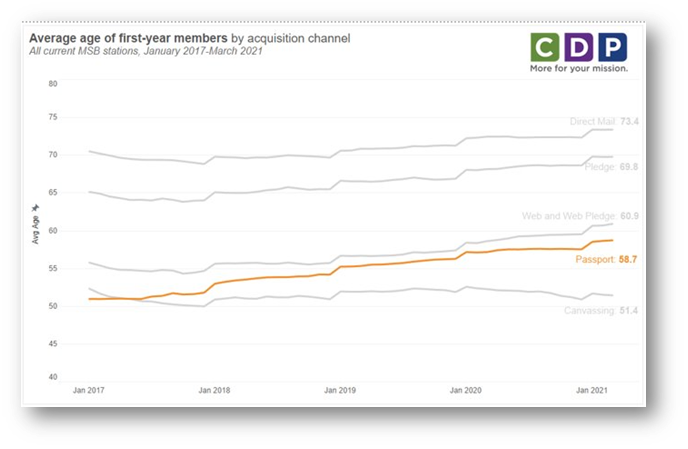Answering Passport’s Age-Old Question
For a recent conference presentation, the CDP Analytics team set out to answer a question: has Passport’s popularity resulted in station files getting younger? Our hypothesis was yes. After all, when the Passport streaming benefit first launched, we noticed right away that Passport-acquired donors tended to be younger. So more Passport donors must be leading to a younger file…right?
Wrong. A hypothesis is a hypothesis for a reason!
After digging into four years of data across the Member Services Bureau, we found that the average age of MSB station members in early 2017 was approximately 69 years old. We then found that the average age of members in early 2021 was…approximately 69 years old. It hadn’t changed at all. In fact, it had stayed remarkably consistent across the entire four-year time period.
So how is this possible? After all, Passport is driving a significantly larger share of new donors in 2021 than in 2017. While 2017 saw 10% of all new MSB donors joining via Passport, by 2021 that has jumped to a whopping 30%.
What we found is that it’s the age of Passport donors that is changing. In 2017, the average age of a Passport-acquired donor was 51. By March 2021, it was nearly 59.
Why is this happening? Well, this is the point where we need to come up with hypotheses for which we don’t have clear answers in the data. But a few possibilities:
Donors will give where you ask them to give. Stations are promoting Passport much more heavily than they were four years ago. When it was first introduced, someone had to seek out Passport. Now, Passport is actively promoted to donors/prospects. That means:
Donors who are aging into traditional nonprofit giving cohorts and were primed to give now have Passport as one of the most visible avenues for giving.
During the pandemic, the popularity of digital engagement, and streaming services in particular, exploded. As a result, interacting online has been normalized for older donors who may have once preferred to donate via offline channels and to spend their entertainment dollars in the physical world.
We’re all getting older: a donor who is 70 now is younger than a donor who was 70 ten years ago — of course. The 70-year-old in 2021 was in her 40s when the internet became popular and is much more likely than a 70-year-old even five years ago to have an email address and be comfortable using the internet.
What does this mean for us as fundraisers? First, if you want to counteract the aging of your file, consider door-to-door canvassing. It’s one of the only acquisition strategies that is proven to consistently deliver younger donors.
And while you’re working to build the file you want for tomorrow, make the most of the file you have today by offering services and conveniences older donors will value and appreciate. Examples include Freewill, CDP’s online will generator that has secured hundreds of thousands of dollars in legacy gifts for stations in just a few short months.
As for Passport donors, we should be open to rethinking who our “Passport donors” are and how we communicate with them.
The hopeful takeaway from these findings is that our “Passport donors” are increasingly looking like our traditional donors, not just younger streamers who think of themselves as being enrolled in a pay-as-you-go service. As the lines blur, it also stands to reason that even our philanthropic donors are more likely to associate the value of the Passport benefit with their membership to our stations — which means we’d better make sure that value stays high!

